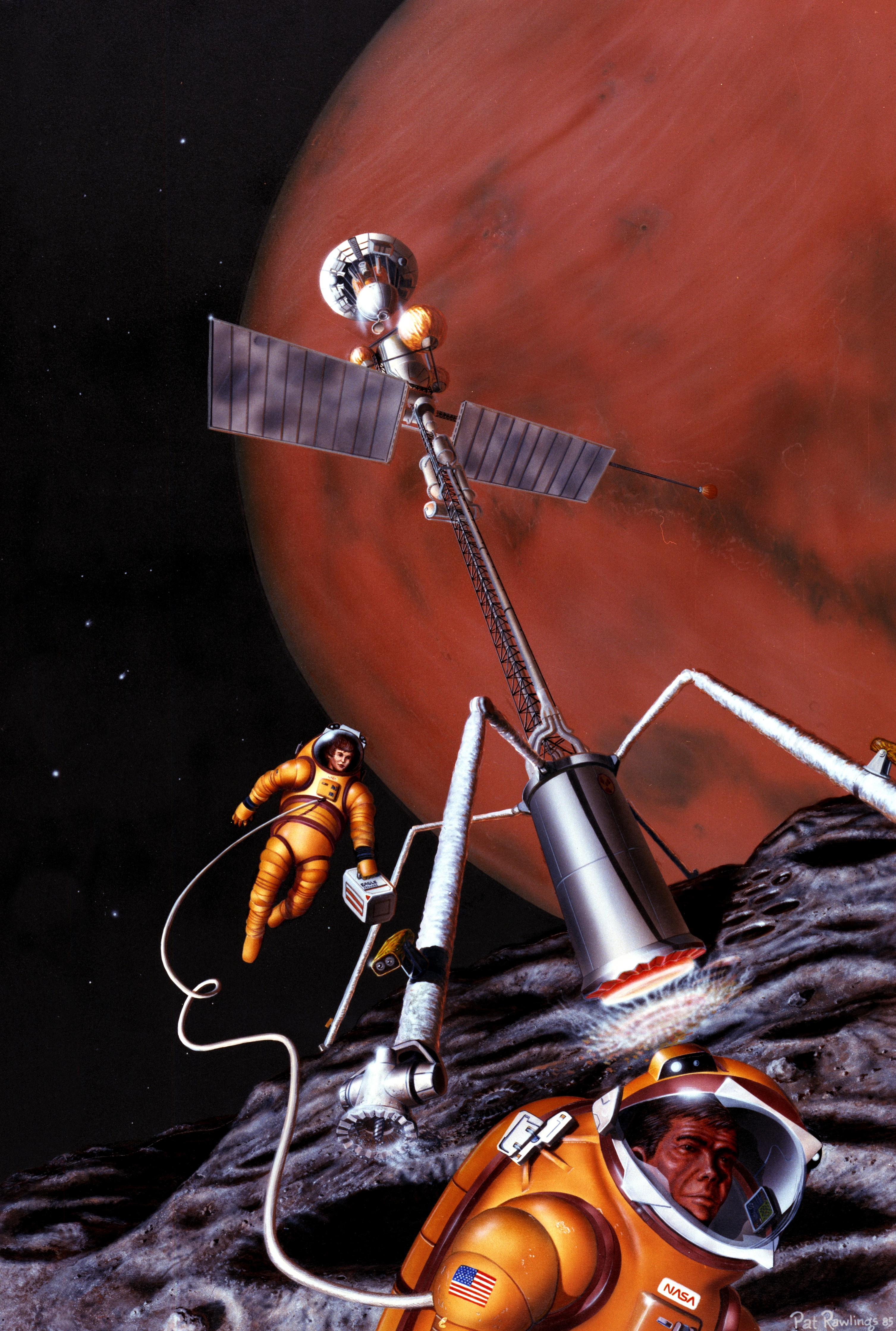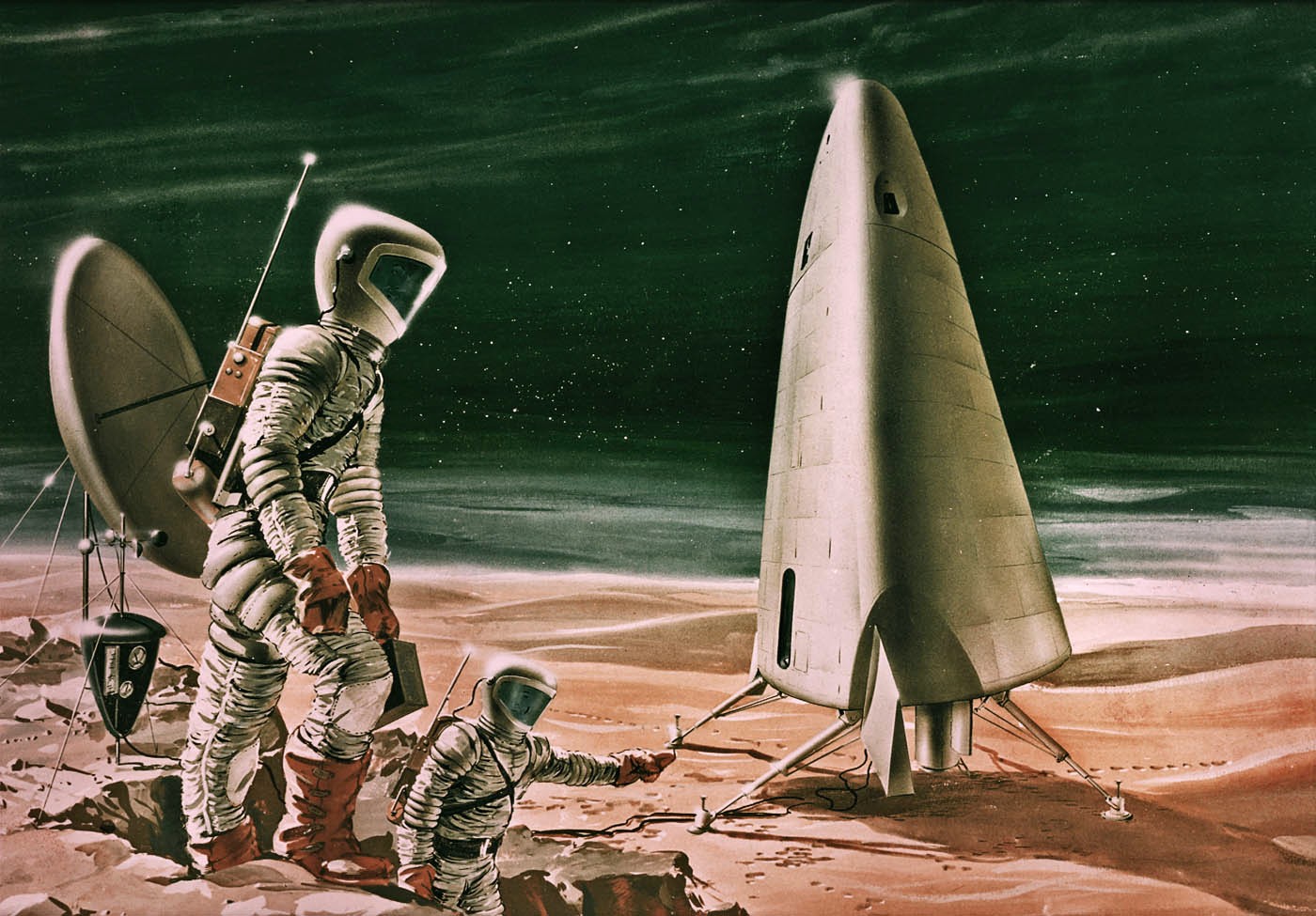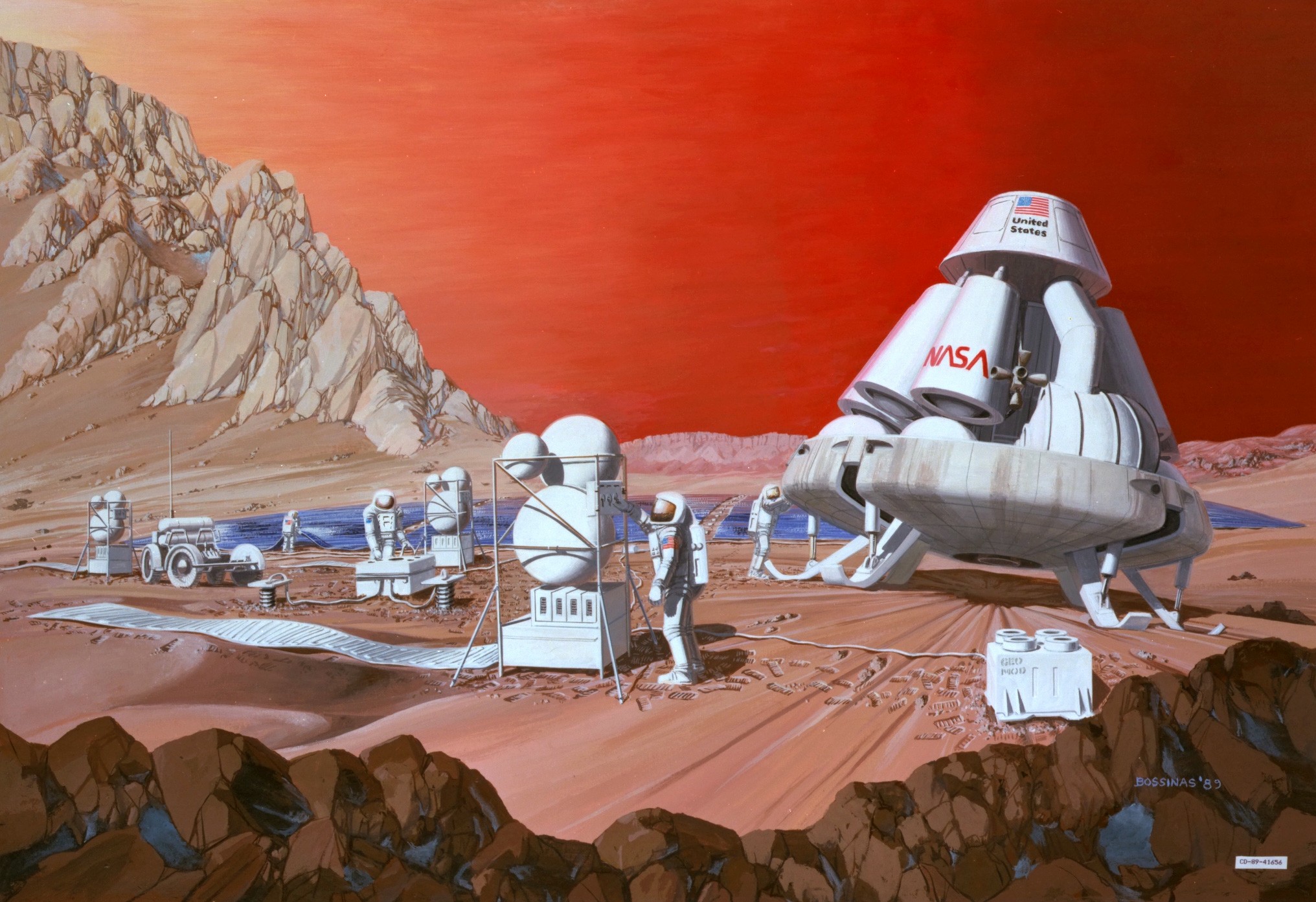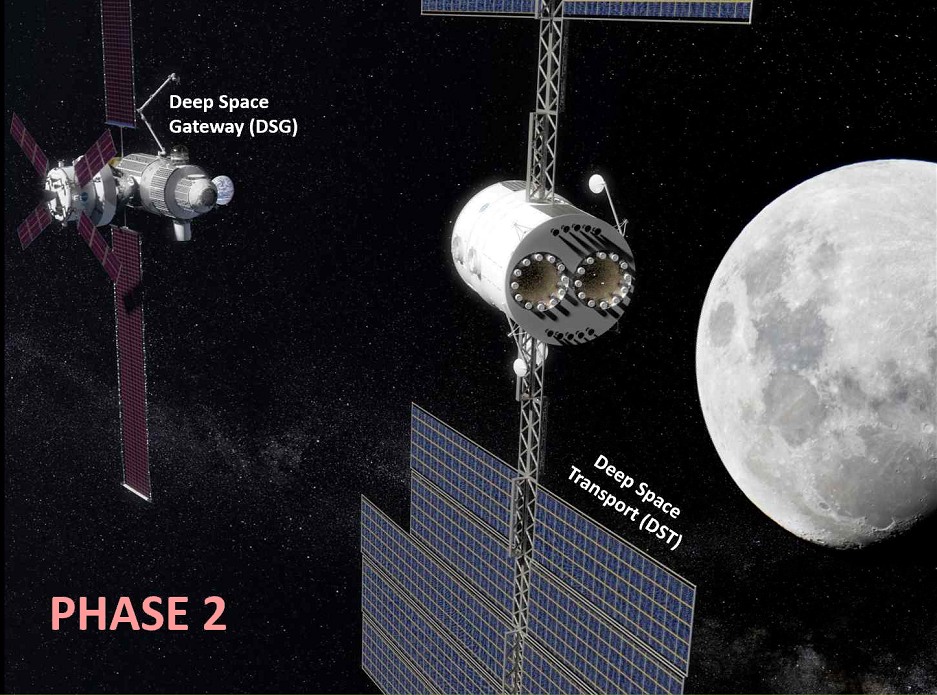 This list of crewed Mars mission plans is a listing of concept studies for a crewed mission to Mars during the 20th and 21st centuries. It is limited to studies done with engineering and scientific knowledge about the capabilities of then current technology, typically for high-budget space agencies like NASA. Mission profiles include crewed flybys, crewed landers, or other types of Mars system encounter strategies.
This list of crewed Mars mission plans is a listing of concept studies for a crewed mission to Mars during the 20th and 21st centuries. It is limited to studies done with engineering and scientific knowledge about the capabilities of then current technology, typically for high-budget space agencies like NASA. Mission profiles include crewed flybys, crewed landers, or other types of Mars system encounter strategies.
Concepts
Many mission concepts for expeditions to Mars were proposed in the late 20th century. David Portree's history volume ''Humans to Mars: Fifty Years of Mission Planning, 1950–2000'' discusses many of these.David S. F. Portree, ''Humans to Mars: Fifty Years of Mission Planning, 1950 – 2000,'' NASA Monographs in Aerospace History Series, Number 21, February 2001. Available aNASA SP-2001-4521
Portree notes that every 26 Earth months a lower energy Earth to Mars transfer opportunity opens, so missions typically coincide with one of these windows. In addition, the lowest available transfer energy varies on a roughly 16-year cycle, with a minimum in the 1969 and 1971 launch windows, rising to a peak in the late 70s, and hitting another low in 1986 and 1988. Also of note, the Mariner 4 Mars flyby in 1965 provided radically more accurate data about the planet; a surface atmospheric pressure of about 1% of Earth's and daytime temperatures of −100 degrees
List
The list is in semi-chronological order, with some groupings, as variation can exist in the dating of a given plan. Various references were consulted.astronautix manned mars missionsAnnie Platoff, ''Eyes on the Red Planet: Human Mars Mission Planning, 1952–1970,'' (1999); available a
NASA/CR-2001-2089280
(July 2001) LEO mass refers to how much hardware must be put in low Earth orbit for the mission. For comparison, the low Earth orbit
Mission proposals
20th century
 Over the last century, a number of mission concepts for such an expedition have been proposed. David Portree's history volume ''Humans to Mars: Fifty Years of Mission Planning, 1950–2000'' discusses many of these.
Over the last century, a number of mission concepts for such an expedition have been proposed. David Portree's history volume ''Humans to Mars: Fifty Years of Mission Planning, 1950–2000'' discusses many of these.
Wernher von Braun proposal (1947 through 1950s)
Wernher von Braun was the first person to make a detailed technical study of a Mars mission.Annie Platoff, ''Eyes on the Red Planet: Human Mars Mission Planning, 1952–1970,'' (1999); available aNASA/CR-2001-2089280
(July 2001) Details were published in his book ''Das Marsprojekt'' (1952, published in English as ''
U.S. proposals (1950s to 1970s)
 From 1957 to 1965, work was done by General Atomics on Project Orion, a proposal for a nuclear pulse propulsion spacecraft. Orion was intended to have the ability to transport extremely large payloads compared to chemical rocketry, making crewed missions to Mars and the outer planets feasible. One of the early vehicle designs was intended to send an 800-ton payload to Mars orbit. The Partial Nuclear Test Ban Treaty of 1963 made further development unviable, and work ended in 1965.
In 1962, Aeronutronic Ford,Franklin Dixon, "Summary Presentation: Study of a Manned Mars Excursion Module," in ''Proceedings of the Symposium on Manned Planetary Missions: 1963/1964 Status'', NASA TM X-53049 (1964). General Dynamics and the Lockheed Missiles and Space Company made studies of Mars mission designs as part of NASA Marshall Spaceflight Center's "Project EMPIRE". These studies indicated that a Mars mission (possibly including a Mercury and Venus fly-by) could be done with a launch of eight Saturn V boosters and assembly in low Earth orbit, or possibly with a single launch of a hypothetical "post Saturn" heavy-lift vehicle. Although the EMPIRE missions were never proposed for funding, they were the first detailed analyses of what it would take to accomplish a human voyage to Mars using data from actual NASA spaceflight, laying the basis for future studies, including significant mission studies by TRW, North American, Philco, Lockheed, Douglas, and General Dynamics, along with several in-house NASA studies.
Following the success of the Apollo Program, von Braun advocated a crewed mission to Mars as a focus for NASA's crewed space program. Von Braun's proposal used Saturn V boosters to launch
From 1957 to 1965, work was done by General Atomics on Project Orion, a proposal for a nuclear pulse propulsion spacecraft. Orion was intended to have the ability to transport extremely large payloads compared to chemical rocketry, making crewed missions to Mars and the outer planets feasible. One of the early vehicle designs was intended to send an 800-ton payload to Mars orbit. The Partial Nuclear Test Ban Treaty of 1963 made further development unviable, and work ended in 1965.
In 1962, Aeronutronic Ford,Franklin Dixon, "Summary Presentation: Study of a Manned Mars Excursion Module," in ''Proceedings of the Symposium on Manned Planetary Missions: 1963/1964 Status'', NASA TM X-53049 (1964). General Dynamics and the Lockheed Missiles and Space Company made studies of Mars mission designs as part of NASA Marshall Spaceflight Center's "Project EMPIRE". These studies indicated that a Mars mission (possibly including a Mercury and Venus fly-by) could be done with a launch of eight Saturn V boosters and assembly in low Earth orbit, or possibly with a single launch of a hypothetical "post Saturn" heavy-lift vehicle. Although the EMPIRE missions were never proposed for funding, they were the first detailed analyses of what it would take to accomplish a human voyage to Mars using data from actual NASA spaceflight, laying the basis for future studies, including significant mission studies by TRW, North American, Philco, Lockheed, Douglas, and General Dynamics, along with several in-house NASA studies.
Following the success of the Apollo Program, von Braun advocated a crewed mission to Mars as a focus for NASA's crewed space program. Von Braun's proposal used Saturn V boosters to launch Soviet mission proposals (1956 through 1969)
The Martian Piloted Complex (MPK) was a proposal by Mikhail Tikhonravov of the Soviet Union for a crewed Mars expedition, using the (then-proposed) N1 rocket, in studies from 1956 to 1962. The Soviets sent many probes to Mars with some noted success stories, including Mars atmospheric entry, but the overall rate of success was low. (see Mars 3) Heavy Interplanetary Spacecraft (known by the Russian acronym TMK) was the designation of a Soviet space exploration proposal in the 1960s to send a crewed flight to Mars and Venus (TMK-MAVR design) without landing. The TMK spacecraft was due to launch in 1971 and make a 3-year-long flight including a Mars fly-by, at which time probes would have been dropped. The project was never completed because the required N1 rocket never flew successfully. The ''Mars Expeditionary Complex'', or "'MEK"' (1969) was another Soviet proposal for a Mars expedition that would take a crew from three to six to Mars and back with a total mission duration of 630 days.Case for Mars (1981–1996)
Following the Viking missions to Mars, between 1981 and 1996, several conferences named the Case for Mars were held at the University of Colorado at Boulder. These conferences advocated human exploration of Mars, presented concepts and technologies, and held a series of workshops to develop a baseline concept for the mission. It proposed use of in-situ resource utilization to manufacture rocket propellant for the return trip. The mission study was published in a series of proceedings volumes. Later conferences presented alternative concepts, including the "Mars Direct" concept of Robert Zubrin and David Baker; the "Footsteps to Mars" proposal ofFootsteps to Mars pdf file
/ref> which proposed intermediate steps before the landing on Mars, including human missions to Phobos; and the "Great Exploration" proposal from
NASA Space Exploration Initiative (1989)
 In response to a presidential initiative, NASA made a study of a project for human lunar- and Mars exploration as a proposed follow-on to the International Space Station. This resulted in a report, called the ''90-day study'', in which the agency proposed a long-term plan consisting of completing the Space Station as "a critical next step in all our space endeavors," returning to the Moon and establishing a permanent base, and then sending astronauts to Mars. This report was widely criticized as too elaborate and expensive, and all funding for human exploration beyond Earth orbit was canceled by Congress.
In response to a presidential initiative, NASA made a study of a project for human lunar- and Mars exploration as a proposed follow-on to the International Space Station. This resulted in a report, called the ''90-day study'', in which the agency proposed a long-term plan consisting of completing the Space Station as "a critical next step in all our space endeavors," returning to the Moon and establishing a permanent base, and then sending astronauts to Mars. This report was widely criticized as too elaborate and expensive, and all funding for human exploration beyond Earth orbit was canceled by Congress.
Mars Direct (early 1990s)
Because of the greater distance, the Mars mission would be much more risky and expensive than past Moon flights. Supplies and fuel would have to be prepared for a 2- to 3-year round trip and the spacecraft would need at least partial shielding from ionizing radiation. A 1990 paper by Robert Zubrin and David A. Baker, then ofCase for Mars
conference series. Over the next decade, Zubrin developed it into a mission concept, Mars Direct, which he presented in a book, '' The Case for Mars'' (1996). The mission is advocated by the
International Space University (1991)
In 1991 in Toulouse, France, the International Space University studied an international human Mars mission. They proposed a crew of 8 traveling to Mars in a nuclear-powered vessel with artificial gravity provided by rotation. On the surface, 40-tonne habitats pressurized to were powered by a 40 kW photovoltaic array.NASA Design reference missions (1990s)
 In the 1990s, NASA developed several conceptual-level human Mars exploration architectures. One of these was NASA Design reference mission 3.0 (DRM 3.0) to stimulate further thought and concept development.
Selected other US/NASA studies (1988–2009):NASA Austere Human Missions to Mars
In the 1990s, NASA developed several conceptual-level human Mars exploration architectures. One of these was NASA Design reference mission 3.0 (DRM 3.0) to stimulate further thought and concept development.
Selected other US/NASA studies (1988–2009):NASA Austere Human Missions to Mars(2009) # 1988 "Mars Expedition" # 1989 "Mars Evolution" # 1990 "90-Day Study" # 1991 "Synthesis Group" # 1995 "DRM 1" # 1997 "DRM 3" # 1998 "DRM 4" # 1999 "Dual Landers"
21st century

NASA Design reference missions (2000+)
The NASAMARPOST (2000–2005)
TheESA Aurora programme (2001+)
 In 2001, the European Space Agency (ESA) laid out a long-term vision of sending a human mission to Mars in 2033. The project's proposed timeline would begin with robotic exploration, a proof of concept simulation of sustaining humans on Mars, and eventually a crewed mission. Objections from the participating nations of ESA and other delays have put the timeline into question, and currently ExoMars, delivered an orbiter to Mars in 2016, have come to fruition.
In 2001, the European Space Agency (ESA) laid out a long-term vision of sending a human mission to Mars in 2033. The project's proposed timeline would begin with robotic exploration, a proof of concept simulation of sustaining humans on Mars, and eventually a crewed mission. Objections from the participating nations of ESA and other delays have put the timeline into question, and currently ExoMars, delivered an orbiter to Mars in 2016, have come to fruition.
ESA/Russia plan (2002)
Another proposal for a joint ESA mission with Russia is based on two spacecraft being sent to Mars, one carrying a six-person crew and the other the expedition's supplies. The mission would take about 440 days to complete, with three astronauts visiting the surface of the planet for a period of two months. The entire project would cost $20 billion and Russia would contribute 30% of these funds.USA Vision for Space Exploration (2004)
 On 14 January 2004,
On 14 January 2004, Mars Society Germany – European Mars Mission (EMM) (2005)
The Mars Society Germany proposed a crewed Mars mission using several launches of a heavy-lift rocket derived from theEncyclopedia Astronautica
China National Space Administration (CNSA) (2006)
Sun Laiyan, administrator of theMars to Stay (2006)
The idea of a one-way trip to Mars has been proposed several times. In 1988, space activist Bruce Mackenzie proposed a one-way trip to Mars in a presentation at the International Space Development Conference, arguing that the mission could be done with less difficulty and expense without a return to Earth. In 2006, former NASA engineer James C. McLane III proposed a scheme to initially colonize Mars via a one-way trip by only one human. Papers discussing this concept appeared in '' The Space Review'', ''NASA Design Reference Mission 5.0 (2007)
NASA released initial details of the latest version conceptual level human Mars exploration architecture ithis
presentation. The study further developed concepts developed in previous NASA DRM and updated it to more current launchers and technology.
Martian Frontier (2007–2011)
Mars 500, the longest high-fidelity spaceflight simulation, ran from 2007 to 2011 in Russia, and was an experiment to assess the feasibility of crewed missions to Mars.NASA Design Reference Mission Architecture 5.0 (2009)
 NASA released an updated version of NASA DRM 5.0 in early 2009, featuring use of the
NASA released an updated version of NASA DRM 5.0 in early 2009, featuring use of the this
document.
NASA
Austere Human Missions to Mars
Mars orbit by the mid-2030s (2010)
In a major space policy speech at Kennedy Space Center on 15 April 2010, Barack Obama predicted a crewed Mars mission to orbit the planet by the mid-2030s, followed by a landing. This proposal was mostly supported by Congress, which approved cancellingRussian mission proposals (2011)
Several Mars mission concepts and proposals have been put forth by Russian scientists. Stated dates were for a launch sometime between 2016 and 2020. The Mars probe would carry a crew of four or five cosmonauts, who would spend close to two years in space. In late 2011, Russian and European space agencies successfully completed the ground-based MARS-500. The biomedical experiment simulating crewed flight to Mars was completed in Russia in July 2000.2-4-2 concept (2011–2012)
In 2012, Jean-Marc Salotti published a new proposal for a crewed Mars mission. The '2-4-2' concept is based on a reduction of the crew size to two astronauts and the duplication of the entire mission. Two astronauts are in each space vehicle, four are on the surface of Mars, and two are once again in each return vehicle. If one set of hardware runs into trouble, the other astronauts are ready to help (two for two). This architecture simplifies the entry, descent, and landing procedures by reducing the size of the landing vehicles. It also avoids the assembly of huge vehicles in LEO. The author claims that his proposal is much cheaper than the NASA reference mission without compromising the risks and can be undertaken before 2030.Boeing Conceptual Space Vehicle Architecture (2012)
In 2012, a conceptual architecture was published by Boeing, United Launch Alliance, and RAL Space in Britain, laying out a possible design for a crewed Mars mission. Components of the architecture include various spacecraft for the Earth-to-Mars journey, landing, and surface stay, as well as return. Some features include several uncrewed cargo landers assembled into a base on the surface of Mars. The crew would land at this base in the "Mars Personnel Lander", which could also take them back into Mars orbit. The design for the crewed interplanetary spacecraft included artificial gravity and an artificial magnetic field for radiation protection. Overall, the architecture was modular to allow for incremental R&D.Mars One (2012–2019)
In 2012, a Dutch entrepreneur group began raising funds for a human Mars base to be established in 2023. The mission was intended to be primarily a one-way trip to Mars. Astronaut applications were invited from the public all over the world, for a fee. The initial concept included an orbiter and small robotic lander in 2018, followed by a rover in 2020, and the base components in 2024. The first crew of four astronauts was to land on Mars in 2025. Then, every two years, a new crew of four would arrive. Financing was intended to come from selling the broadcasting rights of the entire training and of the flight as a reality television show, and that money would be used to contract for all hardware and launch services. In April 2015, Mars One's CEOInspiration Mars Foundation (2013)
In 2013, theBoeing Affordable Mission (2014)
On December 2, 2014, NASA's Advanced Human Exploration Systems and Operations Mission Director Jason Crusan and Deputy Associate Administrator for Programs James Reuthner announced tentative support for the Boeing "Affordable Mars Mission Design" including radiation shielding, centrifugal artificial gravity, in-transit consumable resupply, and a lander which can return. Reuthner suggested that if adequate funding was forthcoming, the proposed mission would be expected in the early 2030s.Mars Semi-Direct Revisited (2016)
As the Earth Return Vehicle was deemed very heavy, Robert Zubrin proposed in 1993 a "semi-direct" scenario, in which the outbound trip is still direct to the surface but the return is split into two steps, first going back to Mars orbit using a relatively small ascent vehicle in order to join a return vehicle that is sent there a long time in advance. As the return is not direct anymore, the scenario is called "semi-direct". In 2016, Jean-Marc Salotti made new calculations and revisited the architecture of the mission, showing that 4 heavy launches of the heaviest version of the NASA Space Launch System would be sufficient for its implementationNASA's Journey to Mars and Moon to Mars Programs (2015–present)
 On October 8, 2015, NASA published its strategy for human exploration and sustained human presence on Mars. The concept operates through three distinct phases leading up to sustainable human presence.
The first stage, already underway, is the "Earth Reliant" phase, which continues using the International Space Station until 2024, validating deep space technologies and studying the effects of long-duration space missions on the human body.
The second stage, "Proving Ground", moves away from Earth reliance and ventures into
On October 8, 2015, NASA published its strategy for human exploration and sustained human presence on Mars. The concept operates through three distinct phases leading up to sustainable human presence.
The first stage, already underway, is the "Earth Reliant" phase, which continues using the International Space Station until 2024, validating deep space technologies and studying the effects of long-duration space missions on the human body.
The second stage, "Proving Ground", moves away from Earth reliance and ventures into SpaceX Mars transportation infrastructure (2016–present)
In 2016,Mars Base Camp (2016)
Deep Space Transport (2017)
 The Deep Space Transport (DST), also called Mars Transit Vehicle, is a crewed interplanetary spacecraft concept by NASA to support science exploration missions to Mars of up to 1,000 days.Finally, some details about how NASA actually plans to get to Mars
The Deep Space Transport (DST), also called Mars Transit Vehicle, is a crewed interplanetary spacecraft concept by NASA to support science exploration missions to Mars of up to 1,000 days.Finally, some details about how NASA actually plans to get to MarsEric Berger, ''ARS Technica''. March 28, 2017.NASA Unveils the Keys to Getting Astronauts to Mars and Beyond
Neel V. Patel, ''The Inverse''. April 4, 2017. It would be composed of two elements - an Orion capsule and a propelled habitation module.Deep Space Gateway -Enabling Missions to Mars
— Shakedown Cruise Simulating Key Segments of Mars Orbital Mission. ''Mars Study Capability Team'' (2018). Michelle Rucker, John Connolly. NASA. As of April 2018, the DST is still a concept to be studied, and NASA has not officially proposed the project in an annual U.S. federal government budget cycle.Cislunar station gets thumbs up, new name in President's budget request
Philip Sloss, ''NASA Spaceflight''. March 16, 2018.NASA evaluates EM-2 launch options for Deep Space Gateway PPE
Philip Sloss, ''NASA Spaceflight''. December 4, 2017. The DST vehicle would depart and return from the Lunar Gateway to be serviced and reused for a new Mars mission.
Tianwen series (2020)
On April 24, 2020, the Chinese planetary exploration mission was named "Tianwen series", the first Mars exploration mission was named " Tianwen-1", and the subsequent planetary missions were numbered in turn.See also
* Colonization of Mars * Exploration of Mars * Human mission to Mars * Manned Venus flyby * Mars sample-return mission *References
Further reading and external links
Mars Expeditions and Flybys
an
List of most crewed mission projects to Mars
Images from ''Colliers'' Magazine of the Von Braun Moon and Mars missions
Reference Mission Version 3.0, Addedum to Human Exploration of Mars
(Design Reference Mission 3.0)
''When Will We Land on Mars?'' by Dr. Werner Von Braun
(''
Space Sailing, by Jerome L. Wright
(Google Books link)
Martian Moon Exploration Conference (2007)
Future Planetary Exploration
Space Gizmo- Concept Art
Wandering Space : Mars
by '' David Portree'' {{DEFAULTSORT:Mars, crewed mission plans Exploration of Mars * 20th century-related lists 21st century-related lists